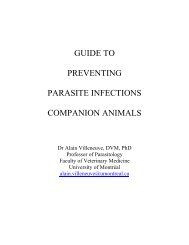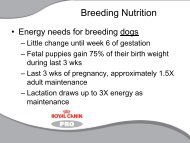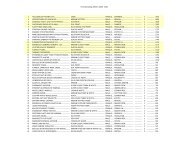COCCIDIOSIS in PERI-WEANING - Royal Canin Canada
COCCIDIOSIS in PERI-WEANING - Royal Canin Canada
COCCIDIOSIS in PERI-WEANING - Royal Canin Canada
You also want an ePaper? Increase the reach of your titles
YUMPU automatically turns print PDFs into web optimized ePapers that Google loves.
<strong>COCCIDIOSIS</strong><br />
CLINICAL SIGNS<br />
Asymptomatic <strong>in</strong>fection <strong>in</strong> adults.<br />
Short-last<strong>in</strong>g hyporexia (1-2 days) towards the age of 4-5 weeks.<br />
Solid and moulded faeces covered with mucus and occasionally frank red blood.<br />
Delayed growth (reversible) affect<strong>in</strong>g unevenly one or several puppies from the litter.<br />
DEFINITION<br />
Digestive protozoan <strong>in</strong>fection of puppies, with cl<strong>in</strong>ical expression <strong>in</strong> the whelp<strong>in</strong>g area or nursery around the<br />
wean<strong>in</strong>g period. Eighty percent (80%) of collective coprological exam<strong>in</strong>ations carried out dur<strong>in</strong>g breed<strong>in</strong>g on<br />
wean<strong>in</strong>g puppies present mucoid diarrhoea call<strong>in</strong>g to m<strong>in</strong>d the presence of Coccidia.<br />
CAUSES<br />
Coccidiosis is attributable to the development of a dog-specific coccidium <strong>in</strong> dogs (Isospora canis or Isospora<br />
ohioensis). There is no <strong>in</strong>ter-species contam<strong>in</strong>ation (e.g. from poultry, rabbits or cats).<br />
PREDISPOSING FACTORS<br />
Breed predisposition: Golden and Labrador Retriever puppies seem to suffer from more severe symptoms<br />
than other puppies of the same size.<br />
Affected small breed puppies may even die from hypoglycaemia due to a short period (6 hours) of anorexia<br />
Decreased milk supply.<br />
DIAGNOSIS<br />
Highly suggestive cl<strong>in</strong>ical diagnosis ("sticky and rubbery" faeces dur<strong>in</strong>g peri-wean<strong>in</strong>g, general condition<br />
rarely affected).<br />
Collective parasitological coproscopy on mixed faeces (com<strong>in</strong>g from all the puppies from a litter, liv<strong>in</strong>g the<br />
same box or yard) collected dur<strong>in</strong>g the excretion peak (5 to 7 weeks).<br />
Detection of oocysts typical of coccidians from the Isospora genus (oocyst size allows dist<strong>in</strong>guish<strong>in</strong>g the<br />
Isospora ohioensis and Isospora canis species).<br />
Paradoxically, the coprological exam<strong>in</strong>ation may result negative dur<strong>in</strong>g a symptomatic period and become<br />
positive dur<strong>in</strong>g convalescence.<br />
Histological diagnosis is possible <strong>in</strong> case a puppy dies, provided samples (distal small <strong>in</strong>test<strong>in</strong>e, ileocolic<br />
valve, and proximal colon) are fixed <strong>in</strong> 10% formaldehyde less than 6 hours after death. Hepatomegaly<br />
associated with fat liver discolouration may be observed, too, as a consequence of hypoglycaemia (ma<strong>in</strong>ly <strong>in</strong><br />
the small breed puppies)<br />
DIFFERENTIAL DIAGNOSIS<br />
In kennels, cl<strong>in</strong>ical signs are sufficiently suggestive not to be mixed up with other pathogens responsible for<br />
haemorrhagic diarrhoea. After the sale, diagnosis may become more difficult on an isolated puppy s<strong>in</strong>ce the<br />
most mucoid faeces are not usually those that conta<strong>in</strong> the largest amount of oocysts.<br />
Haemorrhagic rectocolitis due to stress (rare at this age).<br />
Parvovirosis (panleukopaenia, lack of vitality and energy, test for CPV <strong>in</strong> faeces).<br />
Cryptosporidiosis.<br />
CG - Coccidiosis F<strong>in</strong>al draft 1/3
TREATMENT<br />
The efficacy of clazuril, toltrazuril or diclazuril (2.5 mg/kg/puppy as one oral dose) towards the age of<br />
4 weeks, to be renewed fifteen days later, when necessary..<br />
Follow<strong>in</strong>g sale by the breeder, sulphonamides are sufficient.<br />
Intest<strong>in</strong>al demulcent (e.g. smectite).<br />
Yeasts.<br />
Lactic ferments (yoghurt).<br />
OAA (oligosaccharide anti-adhes<strong>in</strong>s)<br />
PROGNOSIS<br />
Benign prognosis, usually, although treatments only limit cl<strong>in</strong>ical expression without eradicat<strong>in</strong>g the parasite<br />
from the breed<strong>in</strong>g facilities.<br />
The number of oocysts has no correlation with the severity of cl<strong>in</strong>ical signs.<br />
In the absence of treatment, the puppy spontaneously elim<strong>in</strong>ates parasites and last<strong>in</strong>g immunity (through<br />
local IgA) develops (self-limit<strong>in</strong>g illness).<br />
The prognosis is poorer when the disease is complicated by <strong>in</strong>tercurrent <strong>in</strong>fections (cryptosporidiosis,<br />
coronavirosis, parvovirosis, candidiasis).<br />
After-effects of chronic malabsorption may be observed when the lam<strong>in</strong>a propria is affected (haemorrhagic<br />
enteritis caused by Isospora canis, which seems to be more <strong>in</strong>vasive that Isospora ohioensis). In addition,<br />
<strong>in</strong>festation by Isospora canis, which affects both the ileum and colon, should be differentiated from<br />
<strong>in</strong>festation by Isospora ohioensis, which only affects the posterior part of the small <strong>in</strong>test<strong>in</strong>e.<br />
PREVENTION<br />
Diclazuril (same dosage) one week before the average date of onset of symptoms (usually towards 4 and 6<br />
weeks of age).<br />
Control of vectors (rodents, coprophagic <strong>in</strong>sects).<br />
Use of clean<strong>in</strong>g tools and boots exclusively reserved for the whelp<strong>in</strong>g area.<br />
Daily clean<strong>in</strong>g of the whelp<strong>in</strong>g area and removal of faeces to limit the transformation of oocysts <strong>in</strong>to<br />
<strong>in</strong>fective sporulated oocysts.<br />
Rais<strong>in</strong>g food bowls to prevent contam<strong>in</strong>ation by faecal matter.<br />
Avoid keep<strong>in</strong>g puppies on straw litter boxes placed on top of the other.<br />
Natural light<strong>in</strong>g <strong>in</strong> the whelp<strong>in</strong>g area (oocysts are sensitive to UV light).<br />
S<strong>in</strong>ce oocysts are sensitive to heat and desiccation, us<strong>in</strong>g these physical means (e.g. boil<strong>in</strong>g water, heated<br />
steam device, blowtorch on resistant materials) is recommended <strong>in</strong> the whelp<strong>in</strong>g area when it is left empty<br />
for dis<strong>in</strong>fection purpose.<br />
Floor heat<strong>in</strong>g of the whelp<strong>in</strong>g area.<br />
Use of pure ammonia, which is active on oocysts, when animals are absent.<br />
Do not use bleach, which seems to enhance the formation of spores <strong>in</strong> oocysts.<br />
Silicon-coat<strong>in</strong>g of <strong>in</strong>terstices and tile jo<strong>in</strong>ts.<br />
Late wean<strong>in</strong>g (or addition of humanized milk or lactoserum to the wean<strong>in</strong>g diet).<br />
Control of new parasites by parasitological coproscopy dur<strong>in</strong>g the critical period.<br />
CG - Coccidiosis F<strong>in</strong>al draft 2/3
suffer<strong>in</strong>g from coccidiosis (© Dr Philippe Pierson).<br />
microscopic view from the same stool sample (© Dr Philippe Pierson)<br />
Stools from a 2 month old Rottweiler puppy<br />
sporulated Isospora spp oocyst,<br />
Heterogeneous size of puppies from the same litter suffer<strong>in</strong>g from coccidiosis (© Dr Philippe Pierson)<br />
Appearance of their stools (sticky<br />
consistency) (© Dr Philippe Pierson)<br />
CG - Coccidiosis F<strong>in</strong>al draft 3/3







